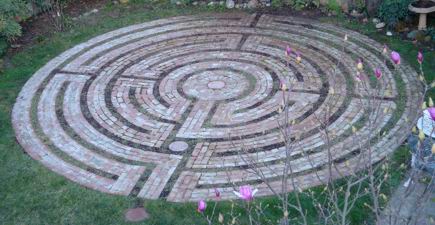Someone wished a Chartres labyrinth and had less space, so I layout this design.
The original Chartres labyrinth has 11 circuits and still some other characteristics, such as the lunations and the six petals in the middle. But it has also a specific alignment which one could call the dramaturgy of these lines.
This is the quick approach to the middle in a few steps with a detour to the left. And this is the quite suddenly and unexpected achievement of the goal after the almost endless bends in the labyrinth in the different sectors, sometimes closer, sometimes further to the middle, from completely outside in a few steps with a detour to the right.
I have seen different 7-circuit medieval types (one should not call them Chartres). But always the alignment was quite an other.
In my opinion the dramaturgy of the original has been preserved in the alignment I have chosen.
Moreover, it is centred. The entrance path, the last path to the middle and the middle itself are situated on the same line. Thereby remains in the 4th circuit a small free space which reminds the fontanel in a classical labyrinth.
Lea Goode-Harris calls in her Santa Rosa Labyrinth this free field the heart space. But, nevertheless, my design is not a Santa Rosa Labyrinth, because this has other lines.
Also it is no small Chartres labyrinth, because it lacks the remaining elements of the original. Robert Ferré has sketched a Petite Chartres. This also has an other alignment.
My design is inspired by the Santa Rosa Labyrinth and the Chartres labyrinth, this is right. However, the alignment is not new, but has been already used in 1981 by Randoll Coate and Adrian Fisher for the Archbishop’s Maze at Greys Court in England. The quite correct name for it would be “topographically symmetrical 7-circuit medieval labyrinth”, as Jeff Saward informed me (in the next Caerdroia 40 he will write about this design).
The labyrinth is scalable.
Here you can see, print or copy the design drawing with the essential measurements as a PDF file.






Pingback: A Meditation On The Labyrinth - Greater Light
Hello Erwin from Melbourne, Australia! I am just writing a blog piece about a Santa Rosa Labyrinth here in Victoria and I stumbled upon your blog and this article.
May I link to this in my blog post?
LikeLiked by 1 person
Surely you can do that.
LikeLike
Thank you!
LikeLike
Pingback: How to make two Chartres Labyrinths from one Chartres Labyrinth | blogmymaze
perles semi precieuses synthetiques
LikeLike
Thank you, Lea for the comment.
I added a photo, with your kindly invitation, of the real and only Santa Rosa Labyrinth.
LikeLike
I am always inspired by your posts Erwin. Your attention to detail and your inquisitive nature is a joy. Thank you for honoring the Santa Rosa Labyrinth design and using it as a jump off point for your own explorations!
LikeLike